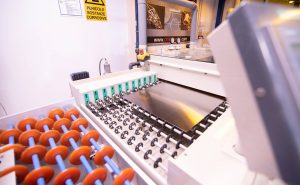PHOTOCHEMICAL MILLING
Photochemical milling or Chemical milling, is a state-of-the-art technique which is an alternative to mechanical cutting. This type of processing is based on the controlled removal of the metal (particularly steels and copper alloys) by means of chemical solutions.
CHIMIMETAL IS ONE OF THE BEST ITALIAN AND GLOBAL CHEMICAL MILLING COMPANIES
Chimimetal is one of the few companies to have the specific know-how and knowledge of the industry to offer the general public of potential users a precise, economical and fast chemical photochemical milling service. Chemical milling (or etching) is also very useful for prototypal activities: this technique requires extremely little time and equipment costs, allowing simple and quick operations to modify and correct the masters. The use of chemical etching on metal is greatly advantageous when complex profiles are required from thin sheets (from 0.05 mm to 1.5 mm) with extremely precise tolerance and without burrs.
We cooperate with technical offices for the optimization of new projects
We produce with a quality system compliant with UNI EN ISO 9001: 2008
We create masters according to the customer’s specific design
We supply your finished details (surface treatments and / or mechanical processing)
TECHNICAL RULES OF THE PHOTOCHEMICAL MILLING
PHOTOCHEMICAL MILLING does not alter in any way the molecular structure, nor the mechanical properties of the processed sheet metal.

THE STEPS OF CHEMICAL MILLING
The steps of the photochemical milling process are as follows:
1.SURFACE PREPARATION
The sheets are cleaned beforehand and treated both mechanically and chemically to make them rougher. Chemical photo-engraving is a highly ecological technique from its first step: in fact, for the entire production chain, state-of-the-art machinery has been chosen for the benefit of products and to protect the environment
2.LAMINATION
On both sides of the sheets, a coating which is photosensitive to UV rays is applied, on which the geometries to be chemically engraved will be imprinted.
3.EXPOSURE
The photosensitive coating of the metal plates is then exposed to UV light and, by using photographic equipment, the outline of the engraved part is reproduced. This photographic equipment used as a stencil is created with the help of CAD data: the parts of the coating that are exposed to UV light polymerise, becoming stable on the sheet and resistant to any agents which are later used.
4.DEVELOPMENT
The unexposed areas on the coating are detached and removed creating the cutting perimeters of the particular parts.
5.CHEMICAL PHOTO-ENGRAVING
An acid solution is sprayed onto the metal plates to dissolve the exposed metal, while the areas protected by the coating are not affected by the treatment. It is a process that does not in any way damage the surrounding material, and the absence of burrs is 100%guaranteed. In the case where a shaped part is coated on one side, the acid solution engraves the metal only on the opposite side creating a low relief (half incision) that can be used, for example, as a folded edge (during subsequent processing), as an area for another particular detail etc.
6.STRIPPING
In the final stripping process, the protective coating of the engraved sheets is removed, leaving the parts connected to the sheet through the attachment points planned at the design stage. Depending on the specific requirements for customisation, additional finishing processes can be carried out: galvanic treatments, separation of the parts from the sheet, 100% inspection of the pieces produced, to name but a few. Finally, the products are packaged following our quality standards or, if required, also following our customers’ directions.
THE ADVANTAGES OF CHEMICAL ETCHING
There are many advantages of chemical photo-engraving, from the high quality result to the speed of production time, from the reduction of costs, to the maintenance of the chemical/physical characteristics of the materials used.
- Sharp and precise cut
- Precision of details
- Production speed
- Low costs
- Unaltered materials
- No processing burrs whatsoever
THE FIELDS OF APPLICATION OF CHEMICAL PHOTO-ENGRAVING
There are a great deal of fields of application of chemical photo-engraving and they range in different areas:
- Electronics
- Mechanical
- Computer science
- Automobile industry
- Electric engines
- Weighing machines
- Fashion accessories
- Modelling for sky, land and sea
- Measurement tools
- Research institutes
- Textile industry
- Electromedical equipment
- Scientific instruments
- Eyewear







